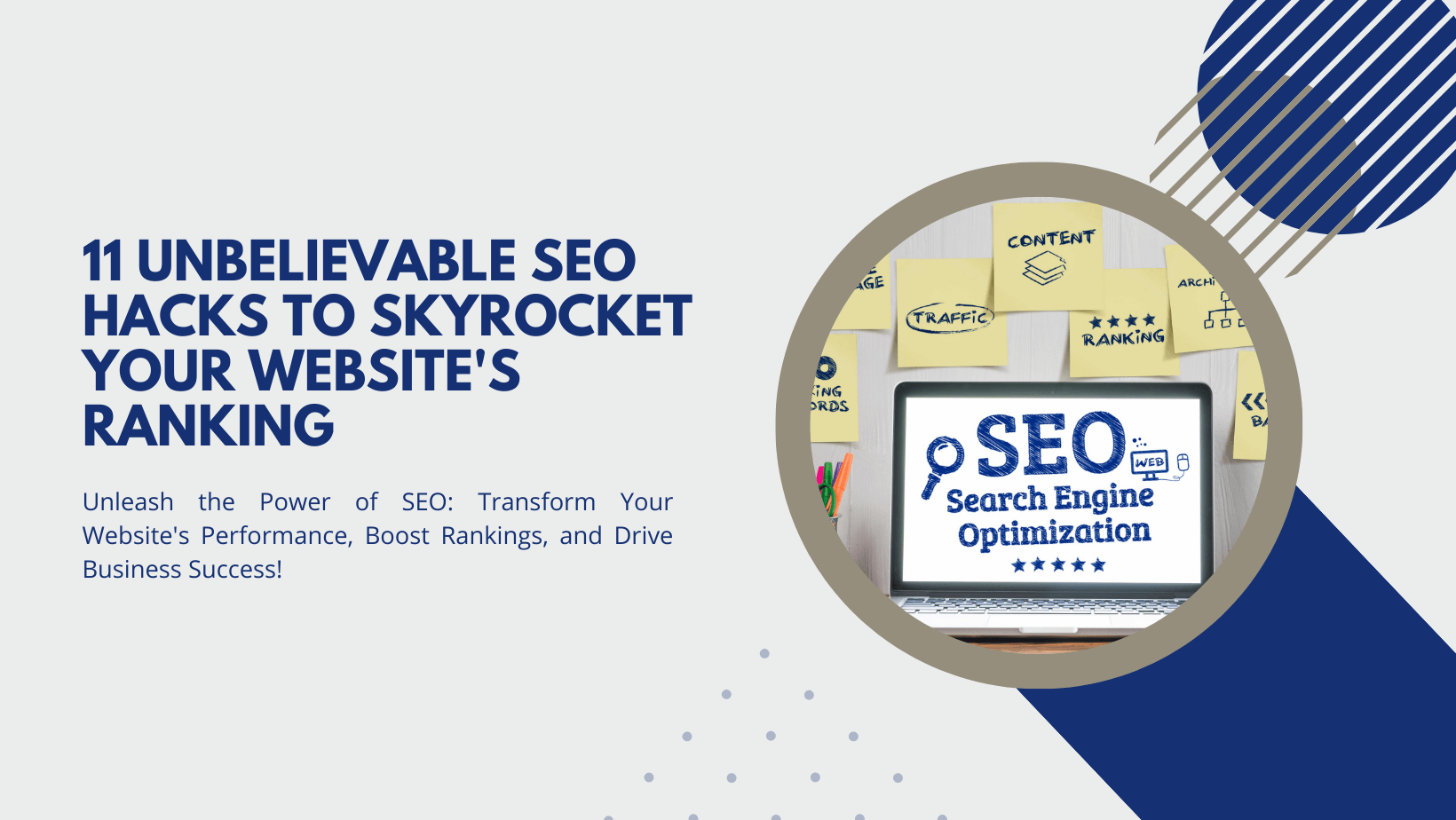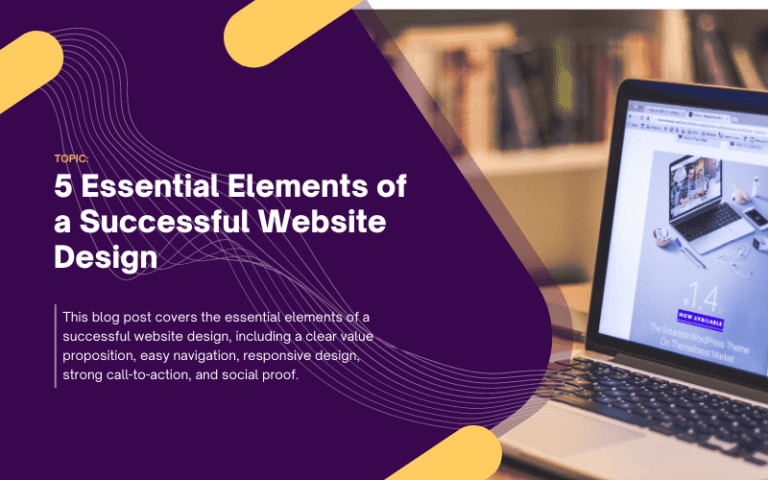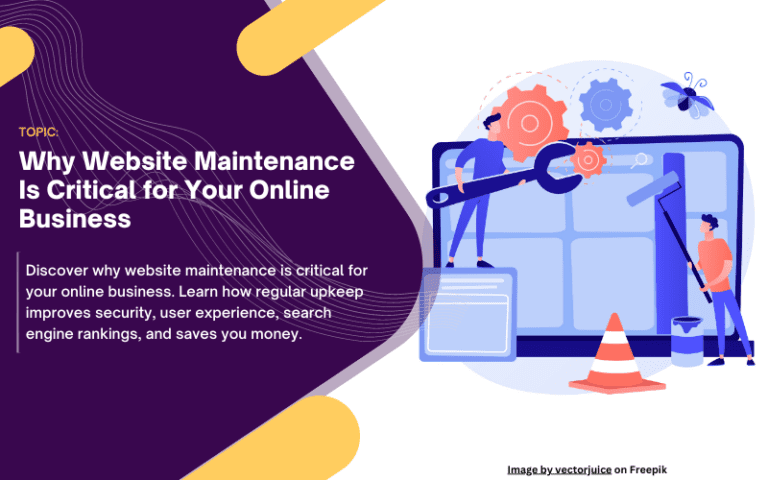11 Unbelievable Search Engine Optimization (SEO) Hacks to Skyrocket Your Website’s Ranking
In today’s digital landscape, Search Engine Optimization (SEO) is the cornerstone of online success. It’s the key to unlocking your website’s potential and ensuring its visibility in search engine results. By implementing effective SEO strategies, you can drive organic traffic, improve your website’s ranking, and increase its online presence. In this comprehensive guide, we will delve into 11 unbelievable SEO hacks that will transform your website and help you achieve remarkable results.
What is Search Engine Optimization (SEO)?

Search Engine Optimization (SEO) is the practice of optimizing a website to improve its visibility and ranking in search engine results pages (SERPs). In simpler terms, SEO helps your website to be more easily found by people searching for relevant information, products, or services on search engines like Google, Bing, or Yahoo.
At its core, SEO involves understanding how search engines work and what factors influence their algorithms. Search engines use complex algorithms to determine the relevance and authority of web pages, and SEO strategies aim to align with these algorithms to improve a website’s organic (non-paid) search ranking.
The primary goal of SEO is to increase organic traffic, attract qualified visitors, and ultimately drive conversions or achieve specific business objectives. By optimizing various aspects of your website, you can enhance its visibility, attract more visitors, and establish a strong online presence.
What are the 11 Unbelievable SEO Hacks to Skyrocket Your Website’s Ranking?
1. Understanding Search Engine Algorithms

To effectively optimize your website for search engines, it’s essential to have a solid understanding of how search engine algorithms work. Search engines like Google, Bing, and Yahoo use complex algorithms to determine the relevance and ranking of web pages in response to user queries.
Understanding search engine algorithms is crucial for effective website optimization. Search engines employ algorithms that consider relevance, authority, user experience, freshness, and user engagement to determine rankings. While the exact algorithms are closely guarded secrets, understanding the key principles can help you align your SEO strategies with search engine requirements. Here a some:
- Optimizing your content to match user intent and incorporating relevant keywords helps improve relevance.
- Building a strong backlink profile enhances authority.
- Providing a positive user experience through fast loading times, mobile-friendliness, and engaging content is vital.
- Regularly updating content and monitoring user engagement signals contributes to the freshness and user engagement.
- Staying informed about algorithm changes and focusing on valuable content and user experience is key.
To gain more insights into the ranking factors considered by Google, you can refer to the comprehensive guide on Google Ranking Factors by Backlinko.
2. Keyword Research

Keyword research is a critical step in the SEO process that involves identifying and analyzing the search terms or phrases that users enter into search engines. By understanding the keywords that are relevant to your business or industry, you can optimize your website’s content and structure to align with user intent and improve your chances of ranking well in search results.
Comprehensive keyword research involves the following steps:
- Identify your goals: Determine the purpose of your website and the specific objectives you want to achieve through SEO. Are you aiming to drive more traffic, generate leads, or increase sales? Clearly defining your goals will help you focus your keyword research efforts.
- Brainstorm potential keywords: Start by brainstorming a list of words and phrases that are related to your business, products, or services. Think about how your target audience would search for information related to what you offer. Include both broad keywords and long-tail keywords (more specific phrases with lower search volume but higher intent).
- Use keyword research tools: Utilize keyword research tools to expand your list and gather data on search volume, competition, and trends. Popular tools include Google Keyword Planner, SEMrush, Moz Keyword Explorer, and Ahrefs. These tools provide insights into search volume, keyword difficulty, and related keyword suggestions.
- Analyze keyword metrics: Evaluate the metrics associated with each keyword, such as search volume and keyword difficulty. Search volume indicates the average monthly searches for a particular keyword, while keyword difficulty measures the competitiveness of ranking for that keyword. Strike a balance between keywords with high search volume and those with lower competition to maximize your chances of ranking well.
- Consider user intent: Look beyond search volume and analyze the intent behind the keywords. Are users looking for information, making a purchase, or seeking a specific service? Understanding user intent helps you optimize your content to meet their needs effectively.
- Refine your keyword list: Narrow down your keyword list based on relevance, search volume, and user intent. Focus on keywords that align closely with your business objectives and target audience. Consider the competitiveness of each keyword and your website’s current authority when making your final selection.
- Group keywords into clusters: Organize your keywords into clusters or themes based on their relevance and intent. This helps structure your website’s content and enables you to create focused, optimized pages targeting specific keyword groups.
Remember, keyword research is an ongoing process. Continuously monitor keyword performance, analyze changes in search trends, and adapt your keyword strategy accordingly. Regularly revisit your keyword list to identify new opportunities and refine your optimization efforts.
By conducting thorough keyword research, you gain insights into what your target audience is searching for and can tailor your website’s content and optimization strategies accordingly. This helps improve your website’s visibility, attract relevant traffic, and increase your chances of ranking well in search engine results.
3. On-Page Optimization
On-page optimization refers to the practices and techniques used to optimize individual web pages to improve their visibility and relevance in search engine results. By optimizing various on-page elements, you can enhance your website’s chances of ranking higher and attracting organic traffic. Here are the key components of on-page optimization:
- Title Tag: The title tag is an HTML element that specifies the title of a web page. It appears as a clickable headline in search engine results. Optimize your title tags by including relevant keywords and ensuring they accurately describe the content of each page. Keep them concise, compelling, and unique.
- Meta Description: The meta description is a brief summary of the page’s content that appears below the title tag in search results. While it doesn’t directly impact rankings, it influences click-through rates. Craft compelling meta descriptions that entice users to click on your page by highlighting the value and relevance of your content.
- URL Structure: Create search engine-friendly URLs that are descriptive, concise, and easy to read. Include relevant keywords in your URLs to provide both search engines and users with a clear understanding of the page’s content.
- Headings and Subheadings: Use heading tags (H1, H2, H3, etc.) to structure your content and make it more readable. Include relevant keywords in your headings and subheadings to signal the content’s topic and improve its visibility to search engines.
- Keyword Optimization: Incorporate relevant keywords naturally throughout your content, including in the page’s title, headings, subheadings, and body text. However, avoid keyword stuffing, as it can harm your rankings. Focus on creating high-quality, informative content that addresses the user’s search intent.
- Content Optimization: Ensure that your content is valuable, comprehensive, and well-structured. Use relevant keywords in the body text without overdoing it. Include related terms and synonyms to provide a broader context and improve semantic relevance.
- Image Optimization: Optimize images by compressing them for faster loading times, providing descriptive file names, and adding alt text. Alt text helps search engines understand the image’s content and improves accessibility for visually impaired users.
- Internal Linking: Create a logical internal linking structure to guide users and search engine crawlers through your website. Link related pages together using descriptive anchor text. Internal linking helps search engines understand the relationships between different pages on your site and distributes authority throughout your website.
- Mobile-Friendliness: Ensure your website is mobile-friendly and responsive to provide a seamless user experience across devices. Mobile-friendliness is a crucial ranking factor, as search engines prioritize mobile-optimized websites in mobile search results.
- Page Loading Speed: Optimize your website’s loading speed by compressing images, minifying code, utilizing caching techniques, and choosing a reliable hosting provider. Fast-loading pages improve user experience and positively impact search engine rankings.
Remember, on-page optimization should always prioritize user experience and valuable content. Provide relevant and engaging content that satisfies user intent and incorporates optimization techniques to improve its visibility to search engines. By implementing effective on-page optimization strategies, you can enhance your website’s visibility, attract targeted organic traffic, and improve your search engine rankings.
4. Off-Page Optimization
Off-page optimization focuses on building your website’s authority and credibility through external factors. Unlike on-page optimization, which focuses on optimizing individual web pages, off-page optimization involves building external signals that indicate your website’s credibility and popularity. Here are the key components of off-page optimization:
- Backlink Building: Backlinks are links from other websites that point to your site. Search engines view backlinks as votes of confidence and use them to determine the authority and relevance of your website. Focus on acquiring high-quality backlinks from reputable and relevant websites through techniques such as guest blogging, influencer outreach, and content promotion.
- Social Media Engagement: Engaging with your audience on social media platforms can indirectly impact your website’s visibility. By sharing valuable content, interacting with followers, and building a strong social media presence, you increase the likelihood of your content being shared and linked to by others.
- Online Directories and Listings: Submitting your website to relevant online directories and listings can help improve your online presence and visibility. Ensure that your business information, such as name, address, and phone number (NAP), is consistent across all directories to enhance credibility.
- Social Bookmarking: Social bookmarking involves submitting and sharing your website’s content on social bookmarking platforms like Reddit, StumbleUpon, and Digg. This can help increase exposure and attract traffic to your site.
- Influencer Marketing: Collaborating with influencers or industry experts can help amplify your brand’s reach and attract valuable backlinks. Seek opportunities to partner with influencers who have a strong online presence and a relevant audience.
- Online Reputation Management: Monitor and manage your online reputation by responding to customer reviews and addressing any negative feedback. A positive online reputation can indirectly impact your website’s credibility and attract more organic traffic.
Off-page optimization should focus on building genuine relationships, providing valuable content, and earning authoritative backlinks naturally. Engage with your target audience, participate in relevant communities, and consistently produce high-quality content that others find valuable and shareable.
By implementing effective off-page optimization strategies, you can enhance your website’s authority, improve search engine rankings, and increase organic traffic.
5. Mobile Optimization

Mobile optimization is the process of ensuring that your website is optimized for a seamless user experience on mobile devices. With the increasing use of smartphones and tablets, search engines prioritize mobile-friendly websites in mobile search results. Here are the key components of mobile optimization:
- Responsive Design: Implement a responsive web design that automatically adjusts the layout and content of your website to fit different screen sizes. This ensures that your website is accessible and visually appealing across various mobile devices.
- Mobile-Friendly Navigation: Simplify navigation for mobile users by using a hamburger menu, clear and intuitive navigation buttons, and a logical page hierarchy. This helps users easily navigate your website and find the information they’re looking for.
- Fast Loading Speed: Optimize your website’s loading speed for mobile devices. Compress images, minify code, and enable caching to reduce page load times. Fast-loading pages enhance the user experience and contribute to higher search engine rankings.
- Readable Font Sizes: Use legible font sizes that are easy to read on smaller screens. Avoid tiny fonts that require zooming in to read the content. Aim for a font size that is comfortable for mobile users without compromising readability.
- Touch-Friendly Elements: Ensure that buttons, links, and interactive elements are designed with touch screens in mind. They should be easily tappable without accidental clicks or frustrating user experiences.
- Mobile-Optimized Content: Adapt your content for mobile consumption. Break up long paragraphs into shorter sections, use subheadings to improve readability, and format content for easy scanning. Make sure videos and images are optimized for mobile viewing as well.
- Accelerated Mobile Pages (AMP): Consider implementing AMP, a Google-backed project that creates ultra-fast loading versions of web pages for mobile devices. AMP pages are designed to load instantly, improving user experience and potentially boosting search engine visibility.
- Test and Optimize: Regularly test your website on different mobile devices and browsers to ensure proper functionality and display. Identify and fix any issues that may arise to provide a smooth and consistent experience across devices.
Mobile optimization is no longer optional but a necessity. By optimizing your website for mobile devices, you provide a positive user experience, increase engagement, and improve your chances of ranking higher in mobile search results. Remember, mobile optimization should focus on responsiveness, speed, user-friendliness, and readability to cater to the needs and preferences of mobile users.
6. Website Loading Speed

Website loading speed has a significant impact on user experience and search engine rankings. Visitors expect fast-loading websites, and search engines favor sites that provide a seamless browsing experience. A slow-loading website can lead to higher bounce rates, lower engagement, and a negative impact on search engine rankings. Here are key aspects to consider for optimizing website loading speed:
- Image Optimization: Compress images without compromising quality to reduce file sizes. Use image formats suitable for the web, such as JPEG or PNG, and consider lazy loading techniques to load images only when they are visible on the screen.
- Minify Code: Minify HTML, CSS, and JavaScript files by removing unnecessary characters, white spaces, and comments. This reduces file sizes and improves loading speed. Utilize tools and plugins that automate code minification.
- Enable Browser Caching: Leverage browser caching to store static resources, such as images, CSS, and JavaScript files, locally on a user’s device. This allows subsequent visits to your website to load faster as the browser retrieves the stored files instead of fetching them from the server again.
- Content Delivery Network (CDN): Use a CDN to distribute your website’s static files across multiple servers worldwide. By delivering content from servers closer to the user’s location, a CDN reduces latency and improves loading speed.
- Reduce HTTP Requests: Minimize the number of HTTP requests by combining multiple CSS and JavaScript files into single files. Avoid excessive use of external scripts and plugins, as each request adds to the loading time.
- Optimize Hosting: Choose a reliable hosting provider that offers fast server response times and ample resources for your website’s needs. Shared hosting plans may be cost-effective but can result in slower loading speeds due to resource limitations.
- Enable Gzip Compression: Enable Gzip compression on your server to compress web page files before they are sent to a user’s browser. This reduces file sizes and accelerates the transmission of data.
- Prioritize Above-the-Fold Content: Load above-the-fold content first, allowing users to see and interact with the most important parts of your website without waiting for the entire page to load. Lazy loading techniques can be used to defer the loading of non-critical elements further down the page.
- Regular Performance Monitoring: Continuously monitor your website’s loading speed using tools like Google PageSpeed Insights or GTmetrix. Identify performance bottlenecks and make necessary optimizations to maintain fast loading times.
A fast-loading website enhances user experience, encourages longer visits, and improves conversion rates. It also positively impacts search engine rankings, as search engines prioritize websites that deliver a seamless and efficient user experience. By implementing these strategies, you can optimize your website’s loading speed and provide a better overall experience for your users.
7. User Experience (UX) and Website Design

User experience (UX) and website design play a crucial role in attracting and retaining visitors, driving engagement, and improving conversion rates. A well-designed website with a positive user experience not only delights users but also contributes to better search engine rankings. Here are key considerations for optimizing UX and website design:
- Intuitive Navigation: Design a clear and intuitive navigation structure that allows users to easily find the information they’re looking for. Use descriptive labels, logical menus, and a consistent layout across your website.
- Responsive Design: Ensure your website is responsive and adapts seamlessly to different devices and screen sizes. A mobile-friendly design is essential as mobile usage continues to rise.
- Clear Call-to-Action (CTA): Incorporate prominent and compelling CTAs throughout your website to guide users towards desired actions. Make sure CTAs are visually distinct and effectively communicate the next steps.
- Visual Appeal: Create a visually appealing website that aligns with your brand identity. Use high-quality images, appropriate color schemes, and readable fonts to enhance the overall aesthetics of your site.
- Readability and Scannability: Present content in a way that is easy to read and scan. Use headings, subheadings, bullet points, and shorter paragraphs to break up text and make it more digestible. Ensure there is sufficient contrast between text and background for optimal readability.
- Loading Speed: Optimize your website’s loading speed, as slow-loading pages can lead to user frustration and increased bounce rates. Compress images, minify code, and leverage caching techniques to improve loading times.
- Content Layout: Organize your content in a logical and structured manner. Use white space effectively to create a clean and uncluttered layout. Consider the F-pattern or Z-pattern reading patterns to guide users’ attention.
- Accessibility: Ensure your website is accessible to all users, including those with disabilities. Follow web accessibility guidelines to provide alternative text for images, proper heading hierarchy, and keyboard navigation support.
- Error Handling: Implement informative error messages and user-friendly forms to help users complete tasks without frustration. Clearly communicate any errors or validation issues and provide helpful instructions for resolution.
- Usability Testing: Conduct usability testing to gather feedback from users and identify areas for improvement. Incorporate user feedback to refine your website design and enhance the overall user experience.
By prioritizing user experience and implementing thoughtful website design, you can create a website that engages users, encourages exploration, and facilitates conversions. A positive user experience not only keeps visitors coming back but also signals to search engines that your website is valuable and relevant. Invest in UX and website design to create a seamless and enjoyable experience for your audience.
8. Content Creation and Optimization
Content creation and optimization are essential for attracting organic traffic, engaging visitors, and establishing your website as a valuable resource. Well-crafted and optimized content helps search engines understand the relevance of your website to user queries. Here are key aspects to consider when creating and optimizing content:
- Keyword Research: Conduct thorough keyword research to identify relevant keywords and phrases that align with your target audience’s search intent. Use keyword research tools to find high-volume and low-competition keywords to incorporate into your content.
- Valuable and Relevant Content: Create high-quality content that provides value to your audience. Offer informative, insightful, and engaging information that answers their questions or addresses their pain points. Ensure that your content is relevant, up-to-date, and unique.
- Compelling Headlines and Meta Tags: Craft attention-grabbing headlines that accurately represent the content of your pages. Incorporate target keywords naturally while maintaining clarity and relevance. Optimize meta tags, including meta descriptions and title tags, to encourage click-through rates in search results.
- Formatting and Structure: Structure your content with clear headings, subheadings, and paragraphs for easy readability. Use bullet points, numbered lists, and bold/italic text to highlight important information. Break up large blocks of text to enhance scannability.
- Keyword Optimization: Incorporate target keywords strategically throughout your content, including in headings, subheadings, and the body text. However, prioritize natural and seamless integration, avoiding keyword stuffing, which can negatively impact user experience and search engine rankings.
- Use of Multimedia: Enhance your content with relevant multimedia elements, such as images, videos, infographics, and charts. Multimedia can improve engagement, provide visual support, and make your content more shareable.
- Internal Linking: Incorporate internal links within your content to guide users to related pages or resources within your website. This helps search engines understand the structure of your site and improves navigation for users.
- Readability and Language: Write in a clear, concise, and accessible manner. Use language appropriate for your target audience and avoid jargon or complex terminology unless necessary. Proofread your content for grammar, spelling, and punctuation errors.
- User Engagement: Encourage user engagement by enabling comments, social sharing buttons, and interactive elements. Respond to comments and engage with your audience to foster a sense of community and build trust.
- Regular Updates: Keep your content fresh and up-to-date by regularly reviewing and updating existing pages. Add new content to cover emerging topics and trends in your industry. Regular updates signal to search engines that your website is active and relevant.
By creating valuable, well-optimized content, you can attract and engage your target audience, establish your expertise, and improve your search engine rankings. Focus on understanding your audience’s needs, addressing their concerns, and delivering content that stands out from the competition. Remember to consistently monitor and analyze the performance of your content to identify opportunities for improvement and refinement.
9. Technical Search Engine Optimization (SEO)
Technical Search Engine Optimization (SEO) focuses on optimizing the technical aspects of your website to enhance its search engine visibility. It involves implementing various technical elements and best practices that enable search engines to crawl, index, and understand your website effectively. Here are the key components of technical SEO:
- Website Crawling and Indexing: Ensure search engines can access and crawl your website’s pages by submitting a sitemap and using a robots.txt file to control what content should be indexed. Check for crawl errors, broken links, and duplicate content that can hinder indexing.
- Website Speed and Performance: Optimize your website’s loading speed to provide a better user experience and improve search engine rankings. Compress images, minify CSS and JavaScript files, leverage browser caching, and utilize content delivery networks (CDNs) to reduce server response time.
- Mobile-Friendly Design: Create a responsive design that adapts to different screen sizes and provides a seamless user experience on mobile devices. Test your website’s mobile-friendliness using tools like Google’s Mobile-Friendly Test and address any issues that arise.
- SSL Certificate and HTTPS: Secure your website by obtaining an SSL certificate and implementing HTTPS encryption. This not only enhances user trust but also helps improve search engine rankings, as Google considers HTTPS as a ranking signal.
- URL Structure and Canonicalization: Use descriptive and user-friendly URLs that reflect the content of your web pages. Implement canonical tags to indicate the preferred version of duplicate content, avoiding potential indexing and ranking issues.
- Structured Data Markup: Implement structured data markup, such as Schema.org, to provide additional context and information about your website’s content to search engines. This can improve the visibility of rich snippets, enhance search results, and enable specific search features like knowledge panels.
- XML Sitemap: Create an XML sitemap that lists all your website’s pages and submit it to search engines. This helps search engines discover and understand the structure of your website, ensuring comprehensive indexing.
- Hierarchy and Internal Linking: Organize your website’s content using a logical hierarchy and implement internal linking between related pages. This facilitates navigation for users and helps search engines understand the importance and relationships between different pages.
- Website Security: Protect your website from malware, hacking attempts, and other security vulnerabilities. Regularly update your website’s software, plugins, and themes to patch any security vulnerabilities and ensure a secure browsing experience for users.
- Monitoring and Optimization: Continuously monitor your website’s performance using tools like Google Search Console and Google Analytics. Track key metrics such as organic traffic, page load times, crawl errors, and rankings. Make necessary optimizations based on data insights to improve your website’s technical performance.
By implementing technical SEO best practices, you can enhance your website’s visibility, accessibility, and user experience. A well-optimized technical foundation allows search engines to effectively crawl and understand your website, leading to improved rankings and increased organic traffic. Stay up-to-date with the latest SEO trends and algorithm changes to ensure your website remains technically optimized for optimal search engine performance.
10. Local Search Engine Optimization (SEO)
Local Search Engine Optimization (SEO) focuses on optimizing your website and online presence to target local customers and improve visibility in local search results. It is particularly important for businesses with physical locations or those serving specific geographic areas. Here are the key components of local SEO:
- Google My Business (GMB): Create and optimize your Google My Business profile, providing accurate and up-to-date information about your business, such as address, phone number, business hours, and website. Encourage customer reviews and engage with them to build credibility.
- NAP Consistency: Ensure consistency in your business name, address, and phone number (NAP) across all online platforms, including your website, directories, social media profiles, and review sites. Consistent NAP information establishes trust and helps search engines associate your business with specific locations.
- Local Keyword Optimization: Identify and target relevant local keywords that include your location. Incorporate these keywords naturally into your website’s content, meta tags, headings, and image alt text to increase visibility in local search results.
- Online Directories and Citations: List your business in relevant online directories and citation websites, such as Yelp, Yellow Pages, and industry-specific directories. Ensure your NAP information is consistent across all directory listings and include a link back to your website.
- Localized Content: Create content that is specific to your local area. Write blog posts, articles, or guides that highlight local events, attractions, or news related to your industry. This can help establish your website as a local authority and attract local visitors.
- Location Pages: If your business has multiple locations, create dedicated location pages for each one. Optimize these pages with location-specific information, including NAP details, unique descriptions, testimonials, and local keywords.
- Online Reviews: Encourage customers to leave reviews on platforms like Google, Yelp, and other relevant review sites. Positive reviews not only boost your reputation but also influence local search rankings. Respond to reviews, both positive and negative, to show your engagement with customers.
- Local Link Building: Build high-quality backlinks from local websites, blogs, and organizations. Seek partnerships with local influencers or collaborate with neighboring businesses to generate local link opportunities. Local links signal to search engines that your business is relevant to the local community.
- Geotargeted Ad Campaigns: Utilize geotargeted advertising campaigns to reach local customers. Platforms like Google Ads and social media advertising allow you to target specific locations and deliver tailored messages to local audiences.
- Mobile Optimization: Optimize your website for mobile devices, as local searches are often conducted on mobile devices. Ensure your website is responsive, loads quickly, and provides a seamless mobile user experience.
By implementing local SEO strategies, you can increase your visibility in local search results, attract targeted local customers, and drive foot traffic to your physical location. Consistency, relevance, and engagement with the local community are key factors in optimizing your online presence for local search success. Monitor your local SEO performance, analyze data, and make necessary adjustments to continually improve your local visibility and reach.
11. Measuring Search Engine Optimization (SEO) Success
Measuring Search Engine Optimization (SEO) success is crucial to understanding the effectiveness of your optimization efforts and identifying areas for improvement. It involves tracking key metrics and analyzing data to evaluate the impact of SEO on your website’s visibility, organic traffic, and conversions. Here are the essential components of measuring SEO success:
- Organic Traffic: Monitor your website’s organic traffic using tools like Google Analytics. Track the number of visitors coming from search engines, as well as the specific keywords or search queries that drive traffic to your site. Analyze trends and changes in organic traffic over time to assess the impact of your SEO strategies.
- Keyword Rankings: Keep track of your website’s keyword rankings in search engine results pages (SERPs). Use keyword tracking tools to monitor your rankings for target keywords and track progress. Identify keywords that are performing well and those that need improvement.
- Click-Through Rates (CTRs): Analyze the click-through rates of your organic search listings. A higher CTR indicates that your meta tags, including title tags and meta descriptions, are compelling and relevant to users’ search queries. Optimize your meta tags to improve CTRs and attract more organic traffic.
- Conversion Rates: Measure the conversion rates of your website, such as form submissions, purchases, or other desired actions. Connect conversion tracking tools, like Google Analytics or third-party analytics platforms, to gain insights into the effectiveness of your SEO efforts in driving user engagement and conversions.
- Bounce Rates: Monitor the bounce rates of your web pages, which indicate the percentage of visitors who leave your site after viewing a single page. High bounce rates may suggest that your content or user experience needs improvement. Analyze bounce rates to identify pages that require optimization.
- Backlink Analysis: Assess the quality and quantity of backlinks pointing to your website. Track the growth of your backlink profile and identify authoritative websites that link to your content. Monitor the impact of backlinks on your organic rankings and traffic.
- Social Signals: Monitor social media engagement metrics, such as likes, shares, and comments on your content. Social signals can indicate the popularity and relevance of your website, which may indirectly impact your search engine rankings.
- Page Load Speed: Measure your website’s loading speed using tools like Google PageSpeed Insights or GTmetrix. Analyze performance data and optimize your website’s speed to enhance user experience and potentially improve search engine rankings.
- Mobile-Friendliness: Assess your website’s mobile-friendliness using tools like Google’s Mobile-Friendly Test. Monitor mobile traffic, engagement, and conversions to determine the impact of mobile optimization on your SEO success.
- SEO Audits: Conduct regular SEO audits to identify technical issues, content gaps, or areas for improvement. Use SEO auditing tools to analyze your website’s health, identify errors, and implement necessary fixes.
By consistently tracking and analyzing these metrics, you can measure the success of your SEO efforts and make data-driven decisions to optimize your website further. Set specific goals, establish benchmarks, and regularly review your performance to ensure continuous improvement and achieve long-term SEO success.
To stay updated with the latest search engine market share statistics, you can visit StatCounter’s Search Engine Market Share page.
Wrapping Up: Unleashing the Power of Search Engine Optimization (SEO)
Unleashing the power of SEO can be a game-changer for your website. By implementing the 11 unbelievable SEO hacks discussed in this guide, you can catapult your website’s ranking, drive organic traffic, and achieve remarkable online success. Remember, SEO is an ongoing process, so stay informed, adapt to algorithm changes, and continuously optimize your website to stay ahead of the competition.
Frequently Asked Questions (FAQs).
Related Posts
- Why Website Maintenance Is Critical for Your Online Business: Learn why website maintenance is crucial for your online business.
- 11 Common Website Design Mistakes to Avoid: Discover the common website design mistakes to steer clear of.
- The Benefits of Responsive Web Design for Your Website: Explore the advantages of responsive web design for your website.
- How to Choose the Right Web Design Agency for Your Business?: Find out how to select the perfect web design agency for your business.
- 5 Essential Elements of a Successful Website Design: Uncover the key elements that make a website design successful.







